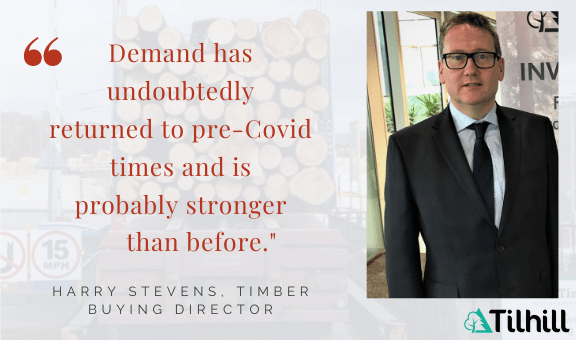The writing of this piece has provided a time for reflection on the period we have just come through and it has been useful to have a cup of tea and pause whilst thinking on what has been one of the most challenging periods of my life in forestry.
Why challenging? Well, generally, life continues its normal path. The previous months requirements for the business are similar to this month and the next and the next. In winter, demand drops and so on and so on. But COVID-19 came along and completely changed the needs of our customers and therefore how we run our business.
We found ourselves in a position where some customers ceased their requirements overnight while others required more. As sawmills initially slowed, or even stopped, the requirement from some of the biofuel plants we supply (and that are very often listed as critical to our infrastructure) was for more virgin fibre as their supplies of recycled material ceased. Now, sawmills have all restarted but the off take of co-products and small roundwood to the panelboard and biomass sector remains patchy.
In essence, the normal steady state that the sector runs at has been completely changed and thrown up in the air. The requirement to manage and plan this process has magnified dramatically. What was previously a weekly planning requirement has become a daily one. The demand on communication with colleagues and the wider sector was similarly increased. I, and many of my colleagues, have become all too familiar with Microsoft Teams software and being more closely associated with the inside of our own homes.
But in amongst all these changes and challenges there have been enormous upsides. Whilst we have experienced moments of stress in our personal lives, both the business and the wider sector, our contractors, colleagues, customers, and suppliers have all shown tremendous resilience, patience, and flexibility in the way they have operated.
We have had, at very short notice, to repurpose our supply chains to provide what the customers have needed exactly when they needed it by and, crucially, we have kept these vital customers supplied. One very good example is a major user of biofuel who are part of the key worker industry. This plant relied largely on the flow of recycled wood the supply of which dried up almost overnight. Colleagues were able to source a virgin fibre supply stream that allowed this plant to continue to operate, whilst at the same time providing several sawmills with an outlet for their wood chips.
I envisage a period between now and late Autumn where demand will continue at a strong level.
Personally, I have learned some valuable lessons about the way the team I am part of operate and have gained a greater insight into our collective strengths. Indeed, as a team building exercise I probably could not have thought of a better one, not that I would advocate doing it too often mind you!
So enough of the collective pat on the back, now for the hard bit. What next?
There is strong demand for sawn timber as everyone it seems (myself and most of my neighbours included) have looked at their gardens and decided that if they are not going on holiday then they are going to replace that fence or redo that border.
Our sales colleagues in the sawmills can sell fencing stock several times over and construction timber demand has picked up to normal demand levels. There are some clouds on the horizon though. Demand for small roundwood has been low, although now increasing, and whilst there are high stocks at roadside currently, we anticipate this coming back into balance between now and new year.
One surprise has been that the market for standing timber does not appear to have weakened at all, as some had anticipated at the start of this period, although the weakness in small roundwood demand has pulled the interest in for poorer quality parcels back slightly. However, all parcels are attracting multiple bidders and good prices.
Indeed, demand has undoubtedly returned to pre-Covid times and is probably stronger than before.
It is likely that this will now be the case until at least the first quarter of next year. It is a good market if you are a grower.
Read more from The Leader 2020: Tilhill’s Annual Magazine:



